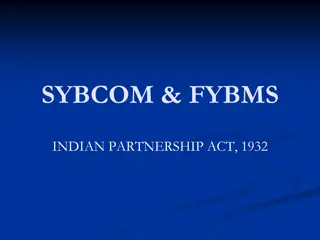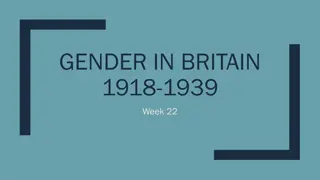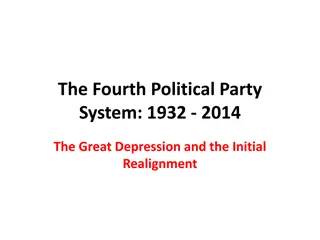Historical Overview of Iraqi Politics from 1932 to Present
The timeline of Iraqi politics from independence in 1932 to the aftermath of the 2003 invasion, including key events like coups, wars, Saddam Hussein's regime, the invasion of Kuwait, and the post-invasion challenges faced by Iraq, such as infrastructure issues, violence, displacement, and the impact on the Iraqi population.
Download Presentation

Please find below an Image/Link to download the presentation.
The content on the website is provided AS IS for your information and personal use only. It may not be sold, licensed, or shared on other websites without obtaining consent from the author.If you encounter any issues during the download, it is possible that the publisher has removed the file from their server.
You are allowed to download the files provided on this website for personal or commercial use, subject to the condition that they are used lawfully. All files are the property of their respective owners.
The content on the website is provided AS IS for your information and personal use only. It may not be sold, licensed, or shared on other websites without obtaining consent from the author.
E N D
Presentation Transcript
1 PROJECT ON MULTI-A(GE)NT SYSTEMS (236824) On paper: Yu, W., Zheng, W. X., Chen, G., Ren, W., & Cao, J. (2011). Second- order consensus in multi-agent dynamical systems with sampled position data. Automatica, 47, 1496 1503. by Vitaly Shalumov
2 Presentation Outline Introduction and overview Mathematical concepts Main contribution Simulations Conclusions and personal thoughts
3 Introduction and overview The cooperative behavior in biology is a well know phenomena (swarming, flocking, shoaling) . The main idea is the same Synchronization of some properties of the group. Realistic dynamical systems Two way communication Second-order dynamics Time delays Sampling time Output feedback (unavailability of some states)
4 Introduction and overview (cont.) Main literature observations When using information of both the current and delayed position states, the sampled position of the multi-agent system converges faster than the standard consensus multi-agent system In some systems, the consensus of a multi-agent system cannot be reached without delayed position information (under the given protocol), but it can be achieved with an even relatively small time delay by appropriately choosing the coupling strengths. Basically, adding memory improves performance
5 Introduction and overview (cont.) What does our paper include??? Uses the tools of algebraic graph theory. Develops necessary and sufficient conditions for consensus of multi-agent system with second-order dynamics Measures both the current and the sampled past state of the position (hybrid system) No use of velocity measurement Does not store the whole spectrum of the delayed position information for more than one sampling time at a time Presents results that can be applied to undirected and directed graphs alike By choosing the appropriate sampling period, a consensus of multi- agent system can be reached if and only if the sampling period is chosen from some particular time intervals
6 Mathematical concepts Basic concepts of algebraic graph theory: The weighted adjacency matrix G = (Gij )N N Only positively weighted directed graphs are considered A directed path from node vi to node vj in G is a sequence of edges (vi,vi1), (vi1,vi2), . . . , (vil,vj) in the directed network with distinct nodes vik , k = 1,2,..., l A root r is a node such that for each node v different from r , there is a directed path from r to v A directed tree is a directed graph, in which there is exactly one root and every node except for this root itself has exactly one parent A directed spanning tree is a directed tree consisting of all the nodes and some edges in G A directed graph contains a directed spanning tree if one of its subgraphs is a directed spanning tree The Laplacian matrix L = (Lij)N N is defined by L??= ?=1,? ? ? ??? ,???= ??? , ? ?
7 Main contribution Consensus protocol with both current and sampled position data: x?t = v? ? ? ? ? v?t = ?=1 ?=1 = ?=1 ???x?t + ?=1 ??? x?t x?t ??? x?t? x?t? ???x?t? t [t?,t?+1) ,? = 1,2, ? t? are the sampling instants satisfying 0 = t0 < t1 < <t?< , and and are the coupling strengths. t?+1 t? = T , where T > 0 is the sampling period Definition 1. The consensus of the multi-agent system is defined as: lim ? x?t x?t = 0, lim ? v?t v?t 0 1 ? ?????t? , t [t?,t?+1) ,? = 1,2, ? ) (? ? ]? ? + ? (? ? ? ??, ? [??,??+?) = 0 ?, ? = 1,2, ? 0 0 ??????t + ?=1 1 0 0 0: ??= (??,??)?,? = ,??? ? = ? ??t = A?? ?=1 ? ? = (?? ? ? )
8 Main contribution (cont.) Consensus depending on the control gains, spectra of the Laplacian matrix, and the sampling period: Theorem 2. Suppose that the network G contains a directed spanning tree. Then, second-order can be reached if and only if 0 < < 1 and ? ?2 1 ? ? 4???2??? ??? 2??? > 0 2 ???2??? ??? 2??? f , ,??,? = ??? ??? ??? ??? ,? = 2, ? ? ?? ????(?) (??) 2 ? ??+????(?) (??) 2 , ??= ??= Corollary 2. Suppose that the network G contains a directed spanning tree and all the eigenvalues of its Laplacian matrix are real. Then, second-order consensus can be reached if and only if 0 < < and ??? ?? , ? = 2, ?, ? = 0,1,
9 Main contribution (cont.) Remark 2. If all the eigenvalues of the Laplacian matrix are real, which includes the undirected network as a special case, then the condition ? ?? ?? , is very easy to be verified and applied. Interesting: second-order consensus in the multi-agent system can be reached if and only if 0 < < and the sampling period T is not of some particular value. ?? ?? The convergence rate around the critical points ? = is very slow.
10 Main contribution (cont.) Corollary 3. Suppose that the network G contains a directed spanning tree and all the eigenvalues of its Laplacian matrix are real. Then, second-order consensus in system can be reached if 0 < < is satisfied and ? ?? Surprise: second-order consensus cannot be reached in a general directed network with complex Laplacian eigenvalues for a sufficiently small or a sufficiently large sampling period T 0 < ? <
11 Main contribution (cont.) Remark 3. If the network G contains a directed spanning tree and all the eigenvalues of the Laplacian matrix are real, then second-order consensus can be reached for a sufficiently small sampling period T as stated in Corollary 2. However, if there is at least one eigenvalue of the Laplacian matrix having a nonzero imaginary part, then second-order consensus cannot be reached for a sufficiently small sampling period T as shown in Corollary 4, which is inconsistent with the common intuition that the consensus protocol should be better if the sampled information is more accurate for a small sampling period. Interestingly, the nonzero imaginary part of the eigenvalue of the Laplacian matrix leads to possible instability of consensus
12 Simulations Case 1 Sample Time Position and velocity Is there consensus? k 4 k 3 k 2 L 1 2 3 4 Case 1 Case 2 Case 3 T=1[s] T=0.1[s] T= 1[s] 1 1 1 0.8 0.8 1.1 Figure 1 Figure 2 Figure 3 Yes Yes No 3 1 2 1 0 1 1 2 0 1 0 0 1 1 1 1 0 1 3 4 3.1416 1.8138 1.5708 Position and velocity states of the agents, Case 1.
13 Simulations (cont.) Case 2 Sample Time Position and velocity Is there consensus? k 4 k 3 k 2 L 1 2 3 4 Case 1 Case 2 Case 3 T=1[s] T=0.1[s] T= 1[s] 1 1 1 0.8 0.8 1.1 Figure 1 Figure 2 Figure 3 Yes Yes No 3 1 2 1 0 1 1 2 0 1 0 0 1 1 1 1 0 1 3 4 3.1416 1.8138 1.5708 Position and velocity states of the agents, Case 2.
14 Simulations (cont.) Case 3 Sample Time Position and velocity Is there consensus? k 4 k 3 k 2 L 1 2 3 4 Case 1 Case 2 Case 3 T=1[s] T=0.1[s] T= 1[s] 1 1 1 0.8 0.8 1.1 Figure 1 Figure 2 Figure 3 Yes Yes No 3 1 2 1 0 1 1 2 0 1 0 0 1 1 1 1 0 1 3 4 3.1416 1.8138 1.5708 Position and velocity states of the agents, Case 3.
15 Conclusions and personal thoughts If the eigenvalues of the Laplacian matrix are real, then consensus can be reached for any sampling period except at some critical points depending on the spectrum of the Laplacian matrix If there exists at least one eigenvalue of the Laplacian matrix with a nonzero imaginary part, consensus cannot be reached for sufficiently small or sufficiently large sampling periods Nevertheless some disconnected stable consensus regions can be determined by choosing appropriate sampling periods Pros A necessary and sufficient condition for reaching consensus in multi-agent dynamical systems with a general directed network topology is established and demonstrated By using only sampled position data in this paper and without requiring the velocity information of agents in second-order dynamics, it is found in this paper that consensus can be reached by appropriately choosing the sampling period Cons No detailed analysis of the rate of convergence was given (the added simulation case presented interesting result: whether adding an edge increases or decreases the convergence rate is dependent on the sampling time Only the graphs with directed spanning tree were analyzed, without addressing the graphs without a directed spanning tree Future work Non-uniform sampling intervals Nonlinear dynamics with time-varying velocities More general consensus protocols Switching topologies Optimal convergence time
16 Questions?



















![Negligence Liability in Donoghue v. Stevenson [1932]](/thumb/198881/negligence-liability-in-donoghue-v-stevenson-1932.jpg)



